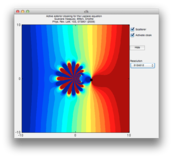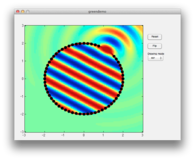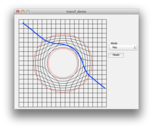Code
Here is a collection of code mostly related to my research.
Active exterior cloaking for the Laplace equation in 2D
 Roughly speaking, this corresponds to a situation where two infinite plates create a uniform voltage gradient in between (vertical isopotential lines). In the absence of a cloaking device a scatterer can be easily detected because isopotential lines are not vertical anymore. If the cloaking device is activated, the scatterer can be moved to the cloaked region. Once it is there, the scatterer is much harder to detect since the isopotential lines are vertical sufficiently far away from the cloaking device.
Roughly speaking, this corresponds to a situation where two infinite plates create a uniform voltage gradient in between (vertical isopotential lines). In the absence of a cloaking device a scatterer can be easily detected because isopotential lines are not vertical anymore. If the cloaking device is activated, the scatterer can be moved to the cloaked region. Once it is there, the scatterer is much harder to detect since the isopotential lines are vertical sufficiently far away from the cloaking device.
License: BSD License
Requires: Matlab
Files: clk.fig and clk.m
Cloaking using the Green's identities for the Helmholtz equation in 2D
 Here we use sources (monopoles and dipoles) that have been precomputed to reproduce a plane wave inside a circular region (you activate all the sources using the OR drawing mode and dragging the cursor along the circular region boundary, the fields will be automatically updated). This can be considered a cloak because these sources can be used to cancel out the field inside the circular region without generating any field (Miller 2006). If any of the sources are removed then the cloak sends out waves, which is (up to a sign) the field that the source emits by itself (you can try this by removing a source using the XOR drawing mode and then using the Flip button. Our approach to cloaking for the Helmholtz equation is to replace parts of the boundary of the cloaked region by a few point-like sources.
Here we use sources (monopoles and dipoles) that have been precomputed to reproduce a plane wave inside a circular region (you activate all the sources using the OR drawing mode and dragging the cursor along the circular region boundary, the fields will be automatically updated). This can be considered a cloak because these sources can be used to cancel out the field inside the circular region without generating any field (Miller 2006). If any of the sources are removed then the cloak sends out waves, which is (up to a sign) the field that the source emits by itself (you can try this by removing a source using the XOR drawing mode and then using the Flip button. Our approach to cloaking for the Helmholtz equation is to replace parts of the boundary of the cloaked region by a few point-like sources.
License: BSD License
Requires: Matlab
Files: greendemo.fig and greendemo.m
Transformation based cloaking
 The main idea here is to generate a medium (annular region) that bends light rays away from the cloaked region (inner circle) in such a way that they come out with the same direction that they entered. This demo has two modes: Transformation mode: allows to adjust the size of the cloaked region. Simply click and drag the inner most circle. Ray mode: alows to draw a ray and calculates how the ray bends as it enters the cloaked region. In this mode press and hold the mouse at the location where the ray starts and release it where the ray ends.
The main idea here is to generate a medium (annular region) that bends light rays away from the cloaked region (inner circle) in such a way that they come out with the same direction that they entered. This demo has two modes: Transformation mode: allows to adjust the size of the cloaked region. Simply click and drag the inner most circle. Ray mode: alows to draw a ray and calculates how the ray bends as it enters the cloaked region. In this mode press and hold the mouse at the location where the ray starts and release it where the ray ends.
For more information about this cloaking method, please see this nice review article:
A. Greenleaf, Y. Kurylev, M. Lassas, G. Uhlmann, Cloaking Devices, Electromagnetic Wormholes and Transformation Optics, SIAM Review 51 (2009), 3-33. doi:10.1137/080716827. Also available from Gunther Uhlmann's webpage.
License: BSD License
Requires: Matlab
Files: transf_demo.fig and transf_demo.m
On the solvability of the discrete conductivity and Schrödinger inverse problems
This is the code accompanying the article: Boyer, Garzella and Guevara Vasquez, On the solvability of the discrete conductivity and Schrödinger inverse problems, SIAM J Applied Mathematics, 76.3 (2016), pp. 1053–1075. doi:10.1137/15M1043479. arxiv:1510.02848.
Authors: Justin Boyer, Jack Garzella and Fernando Guevara Vasquez
Requires: Julia
Files: For more details (including license and instructions) see https://www.math.utah.edu/~fguevara/recov/
Periodic particle arrangements using standing acoustic waves
This is the code accompanying the article: Guevara Vasquez and Mauck, Periodic particle arrangements using standing acoustic waves
, Proceedings of the Royal Society A 475.2232 (2019), p. 20190574. doi:10.1098/rspa.2019.0574. arXiv:1908.08664.
Authors: Fernando Guevara Vasquez and China Mauck
Requires: Matlab
Files: For more details (including license and instructions) see https://github.com/fguevaravas/crystals.
Active Thermal Cloaking and Mimicking
This is the code accompanying the article: Cassier, DeGiovanni, Guenneau and Guevara Vasquez, Active Thermal Cloaking and Mimicking, Proceedings of the Royal Society A 477.2249 (2021), p. 20200941. doi:10.1098/rspa.2020.0941. arXiv:2011.13069.
Authors: Maxence Cassier, Trent DeGiovanni, Sébastien Guenneau and Fernando Guevara Vasquez
Requires: Matlab
Files: For more details (including license and instructions) see https://github.com/fguevaravas/atc.
Active exterior cloaking for the 2D Helmholtz equation with complex wavenumbers and application to thermal cloaking
This is the code accompanying the article: Cassier, DeGiovanni, Guenneau and Guevara Vasquez, Active exterior cloaking for the 2D Helmholtz equation with complex wavenumbers and application to thermal cloaking, Philosophical Transactions of the Royal Society A, 380(2237):20220073, 2022. doi:10.1098/rsta.2022.0073. arXiv:2203.02075. Accepted in the Philosophical Transactions of the Royal Society A.
Authors: Maxence Cassier, Trent DeGiovanni, Sébastien Guenneau and Fernando Guevara Vasquez
Requires: Matlab
Files: For more details (including license and instructions) see https://github.com/fguevaravas/code_AEC.
Cloaking for random walks and a discrete potential theory
This is the code accompanying the manuscript: DeGiovanni and Guevara Vasquez, Cloaking for random walks using a discrete potential theory. arXiv:2405.07961.
Authors: Trent DeGiovanni and Fernando Guevara Vasquez
Requires: Julia
Files: For more details (including license and instructions) see https://github.com/fguevaravas/crwdpt.